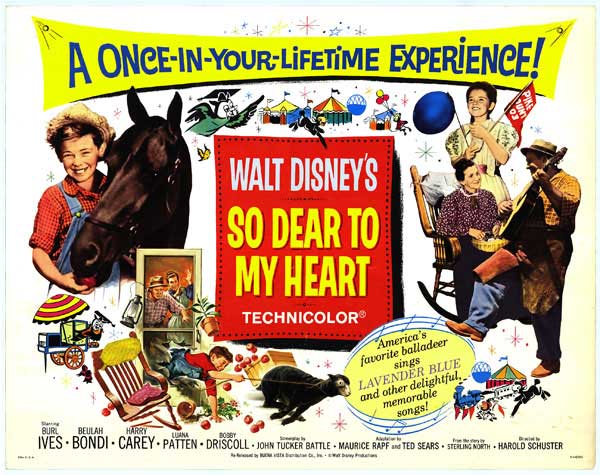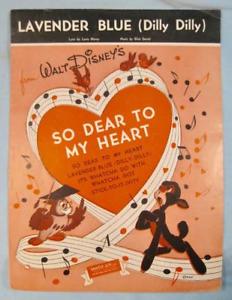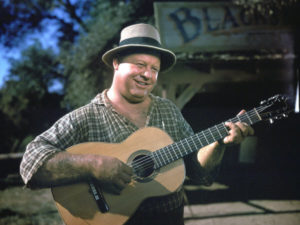
 If the people in the Music Department of the Walt Disney studios–and the folks at Santly-Joy Music in New York City–were disappointed in the returns from other songs from So Dear To My Heart, they had no reason to be morose about the returns form “Lavender Blue (Dilly Dilly)”.
If the people in the Music Department of the Walt Disney studios–and the folks at Santly-Joy Music in New York City–were disappointed in the returns from other songs from So Dear To My Heart, they had no reason to be morose about the returns form “Lavender Blue (Dilly Dilly)”.
Indeed, the song–based upon an eighteenth-century English song–was the biggest hit connected with a Disney production since “Zip-A-Dee-Doo-Dah” nearly two years previous.
As with the other songs from the film, “Lavender Blue” was in place before the end of 1947. And most of the contemporary recordings of the piece are from that hectic period before the second “Petrillo Ban” took effect at midnight on January 1st, 1948.
There were at least five “pop”covers of Larry Morey/Eliot Daniel’s simple little song.
Columbia gave it to versatile Dinah Shore, whose vocal range encompassed everything from torch songs to rustic novelties.
RCA Victor had the version that hit the highest on the Billboard charts–a dance version by Sammy Kaye and his “Swing-and-Sway” orchestra, with a vocal by his vocal group, the Kaydets.
Capitol had a semi-swing version by Jack Smith, assisted by the Clark Sisters. Smith also sang it on his own radio shows.
Mercury had one Anne Vincent record the ditty. Miss Vincent–pretty much a non-entity among collectors–had gotten some of the coin on “You Call Everybody Darlin'” (without taking that much in sales away from the two different recordings by Al Trace), and Mercury may have felt that they could establish Miss Vincent with record buyers. Didn’t work, but ’twas probably worth the effort.
 Decca missed out on having recorded “Lavender Blue” before the Ban hit. So, just after it was all settled, they brought the artist who had introduced the song in “So Dear To My Heart” into their New York studios, backing him up with Captain Stubby and his Buccaneers.
Decca missed out on having recorded “Lavender Blue” before the Ban hit. So, just after it was all settled, they brought the artist who had introduced the song in “So Dear To My Heart” into their New York studios, backing him up with Captain Stubby and his Buccaneers.
Burl Ives was an interesting case. He cast himself as a “folk singer”. But, unlike many of his folk-singing brethren, he did not wear on his sleeve politics with a severe list to port. This apolitical stance stood Ives in good stead when his fellow folk troubadours were being called before committees of Congressmen, and queried with the sixty-four-dollar question of the day: “Are you now, or have you ever been. . . ?'”.
Thus, Ives maintained a career that saw him as an actor, a singer of children’s songs, and a Nashville-Sound crooner.
Today, he is one of those singers who is only heard between Black Friday and Boxing Day–thanks to his singing of “Have a Holly Jolly Christmas” on the soundtrack of the television special “Rudolph The Red-Nosed Reindeer”.
“Lavender Blue” enjoyed a considerable revival in the autumn of 1959, when one Sammy Turner had a hit single with a version that featured the trappings of “uptown rhythm-and-blues’, and a nod towards what would become known as “soul”.
NEXT WEEK: The songs of Cinderella (1950)


 James Parten has overcome a congenital visual disability to be acknowledged as an expert on the early history of recorded sound. He has a Broadcasting Certificate (Radio Option) from Los Angeles Valley College, class of 1999. He has also been a fan of animated cartoons since childhood.
James Parten has overcome a congenital visual disability to be acknowledged as an expert on the early history of recorded sound. He has a Broadcasting Certificate (Radio Option) from Los Angeles Valley College, class of 1999. He has also been a fan of animated cartoons since childhood.










































The song was used in an episode of “The Ghost and Mrs. Muir” which is where I first heard it back in the early 70’s.
The Sherman Brothers include a little “Lavender Blue” inside joke at the end of Ludwig Von Drake’s “The Spectrum Song” (sung by Paul Frees) on the 1961 45 RPM single from Disneyland Records (DBR-34).
https://m.youtube.com/watch?v=5dczpjt5HLo
The episode of Walt Disney’s Wonderful World of Color where this song is introduced contains a different version of the song without the Dilly Dilly-reference.
https://m.youtube.com/watch?v=arZRYbtb20M
According to Wikipedia (not always the most reliable source, I admit) Ives was blacklisted until he came before HUAC and named names. This led to estrangement with many other performers, particularly Pete Seeger. They didn’t make up for over forty years.
Thanks for the article Love it. One other, Capitol records had their rich sounding, fine crooner Jack Smith (not to be confused with the 1920s-early 30s “Whispering Jack Smith’) record it as well.
Here are three other “Lavender Blue” recordings that were in competition with the above:
Vera Lynn recorded it for London Records (London 310).
Independent label Varsity Records had it by the Tyler Duo on Varsity 124.
Another independent, Crystal Records, gave it to a singer named Hugh Cameron on Crystal 185.
Also of note: British progressive-rock band Marillion recorded a version of “Lavender Blue” for their 1985 album, ‘Misplaced Childhood’ (titled simply “Lavender” instead, though).